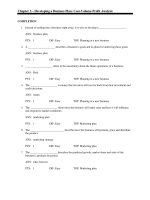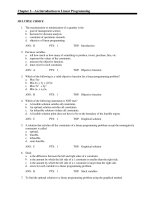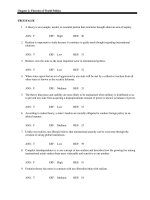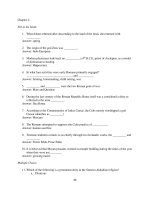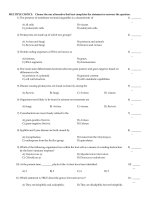Chemistry for changing times 13th edition hill test bank
Bạn đang xem bản rút gọn của tài liệu. Xem và tải ngay bản đầy đủ của tài liệu tại đây (275.09 KB, 20 trang )
Chemistry for Changing Times, 13e (Hill)
Chapter 2 Atoms
2.1 Multiple Choice Questions
1) The Greek word atomos means
A) atom.
B) uncuttable.
C) invisible.
D) continuous.
Answer: B
Diff: 1 Page Ref: Sec. 2.1
LO: 2.1
2) Leucippus and Democritus proposed the "first" atomic view of matter. They arrived at this view
based on
A) many experiments.
B) careful measurements.
C) philosophical and intuitive speculation.
D) All of the above contributed to their atomic view.
Answer: C
Diff: 3 Page Ref: Sec. 2.1
LO: 2.1
3) The ancient Greeks believed that matter was composed of four basic elements. Which one of the
following was NOT one of the four?
A) gold
B) fire
C) water
D) earth
Answer: A
Diff: 2 Page Ref: Sec. 2.1
LO: 2.1
4) An atomic view of matter was first proposed approximately how many years ago?
A) 50
B) 100
C) 200
D) 2500
Answer: D
Diff: 2 Page Ref: Sec. 2.1
LO: 2.1
1
Copyright © 2013 Pearson Education, Inc.
5) Which of the following believed that matter was continuous and was not made up of atoms?
A) Aristotle
B) Dalton
C) Democritus
D) Lavoisier
Answer: A
Diff: 1 Page Ref: Sec. 2.1
LO: 2.1
6) Leucippus and Democritus believed that all of the following statements about matter were true
EXCEPT
A) Matter was made up of atoms.
B) Each type of matter had a distinctive size and shape.
C) Matter was continuous.
D) Substances are mixtures of different kinds of atoms.
Answer: C
Diff: 3 Page Ref: Sec. 2.1
LO: 2.1
7) Which of the following statements about atoms is NOT true?
A) Atoms are too small to be seen even with a microscope.
B) Atoms make up every material.
C) Atoms are the smallest particles that are characteristic of a given element.
D) No atoms have been synthesized by scientists.
Answer: D
Diff: 2 Page Ref: Sec. 2.2
LO: 2.2
8) Approximately how many elements occur naturally on Earth?
A) 20
B) 50
C) 90
D) 115
Answer: C
Diff: 2 Page Ref: Sec. 2.2
LO: 2.2
9) The "father of modern chemistry" is
A) Boyle.
B) Lavoisier.
C) Mendeleev.
D) Proust.
Answer: B
Diff: 1 Page Ref: Sec. 2.2
LO: 2.2
2
Copyright © 2013 Pearson Education, Inc.
10) 32 g of sulfur will react with 48 g of oxygen to produce 80 g of sulfur trioxide. If 16 g of sulfur and
100 g of oxygen are placed into a sealed container and allowed to react, what is the mass of the material
in the container after the reaction is completed?
A) 40 g
B) 16 g
C) 100 g
D) 116 g
Answer: D
Diff: 2 Page Ref: Sec. 2.2
LO: 2.3
11) 32 g of sulfur will react with 48 g of oxygen to produce 80 g of sulfur trioxide. If 16 g of sulfur and
100 g of oxygen are placed into a sealed container and allowed to react, what is the mass of sulfur
trioxide in the container after the reaction is completed?
A) 40 g
B) 16 g
C) 100 g
D) 116 g
Answer: A
Diff: 2 Page Ref: Sec. 2.2
LO: 2.3
12) By definition, which of the following can be broken down into simpler substances?
A) compound
B) element
C) gas
D) liquid
Answer: A
Diff: 1 Page Ref: Sec. 2.2
LO: 2.4
13) Lavoisier performed many of the same experiments as his predecessors. The one thing that most
distinguished Lavoisier's work was
A) the results.
B) the mass measurements.
C) the chemicals.
D) the glassware.
Answer: B
Diff: 1 Page Ref: Sec. 2.2
LO: 2.2
3
Copyright © 2013 Pearson Education, Inc.
14) Lavoisier measured the mass of substances before and after chemical reactions and summarized his
observations in a(n)
A) hypothesis.
B) observation.
C) theory.
D) law.
Answer: D
Diff: 2 Page Ref: Sec. 2.2
LO: 2.2
15) Which one of the following statements is NOT a correct statement of the Law of Conservation of
Mass?
A) The mass of a system is dependent upon chemical reactions that may occur.
B) The mass of a system is conserved in a chemical reaction.
C) Matter cannot be created or destroyed.
D) Atoms are conserved in chemical reactions.
Answer: A
Diff: 2 Page Ref: Sec. 2.2
LO: 2.2
16) A mixture containing 50grams of carbon and 75 grams of oxygen is sealed in a flask. The total mass
of the system is 225 grams. The flask is heated to cause the carbon and oxygen to react. The sealed
flask is massed. What is the mass of the sealed flask?
A) 125 grams
B) 150 grams
C) 175 grams
D) 225 grams
Answer: D
Diff: 3 Page Ref: Sec. 2.2
LO: 2.2
17) A student measures 10.5 g of mercury(II) oxide into an open test tube and heats the tube. The heat
causes the mercury(II) oxide to decompose into mercury and oxygen. After reaction, the student finds
the mass of the contents of the tube to be 9.7 g. Which one of the following describes these
observations?
A) The decomposition of mercury(II) oxide does not obey the Law of Conservation of Mass.
B) 0.8 grams of oxygen gas are lost from the tube.
C) There are errors associated with the student's measurements.
D) Heating destroys some mass.
Answer: B
Diff: 3 Page Ref: Sec. 2.2
LO: 2.2
4
Copyright © 2013 Pearson Education, Inc.
18) The amount of carbon on the earth, including the atmosphere,
A) is essentially constant.
B) is decreasing due to consumption of carbon based fuels, such as coal and petroleum.
C) is increasing due to plant and animal growth on the planet.
D) fluctuates dramatically with the seasons.
Answer: A
Diff: 2 Page Ref: Sec. 2.2
LO: 2.2
19) The amount of aluminum on the earth today relative to the amount 100 years ago when Al was first
commercially extracted from bauxite, an aluminum containing ore,
A) is essentially the same.
B) is decreasing rapidly due to production of aluminum beverage containers.
C) is decreasing, but more slowly recently due to interest in recycling.
D) is actually increasing due to recycling efforts and more energy efficient production methods.
Answer: A
Diff: 2 Page Ref: Sec. 2.2
LO: 2.2
20) Hydrogen peroxide decomposes into water and oxygen when exposed to heat or light. A tightly
capped bottle of hydrogen peroxide is placed on a mass scale (a balance) and exposed to light for three
weeks. The mass reading on the scale does not change. This is an example of
A) the Law of Conservation of Mass.
B) the Law of Definite Proportions.
C) the Law of Constant Composition.
D) the Law of Multiple Proportions.
Answer: A
Diff: 2 Page Ref: Sec. 2.2
LO: 2.2
21) Methane can be decomposed into two simpler substances, hydrogen and carbon. Therefore,
methane
A) is a gas.
B) cannot be an element.
C) must be a mixture.
D) must have the formula CH.
Answer: B
Diff: 2 Page Ref: Sec. 2.2
LO: 2.2
22) The ability to recycle aluminum (or glass, or plastic) is ultimately an illustration of
A) the law of the conservation of mass.
B) the law of definite proportions.
C) the ingenuity of chemists.
D) the law of multiple proportions.
Answer: A
Diff: 2 Page Ref: Sec. 2.2
LO: 2.3
5
Copyright © 2013 Pearson Education, Inc.
23) When electricity is passed through molten potassium bromide, two simpler substances, potassium
and bromine, are produced. Therefore, potassium bromide
A) cannot be an element.
B) must be a mixture.
C) has less mass than the resulting potassium and bromine do.
D) must have the formula PB.
Answer: A
Diff: 2 Page Ref: Sec. 2.2
LO: 2.2
24) The Law of Definite Proportions was first stated by
A) Lavoisier.
B) Galileo.
C) Dalton.
D) Proust.
Answer: D
Diff: 1 Page Ref: Sec. 2.2
LO: 2.2
25) When added to a sealed flask and heated, 6.0 g of carbon and 16.0 g of oxygen react to form 22.0 g
of carbon dioxide. How much carbon dioxide is formed when 24.0 g of carbon is reacted with 100.0 g
of oxygen?
A) 40.0 g
B) 44.0 g
C) 88.0 g
D) 112.0 g
Answer: C
Diff: 3 Page Ref: Sec. 2.2
LO: 2.2
26) The observation that 20 g of hydrogen gas always combines with 160 g of oxygen gas to form 180 g
of water, even when there is more than 160 g of oxygen present in the reaction container, illustrates the
law of
A) definite proportions.
B) multiple proportions.
C) ideal gases.
D) excess reactants.
Answer: A
Diff: 2 Page Ref: Sec. 2.2
LO: 2.3
6
Copyright © 2013 Pearson Education, Inc.
27) No matter how much extra oxygen is available, 12 grams of carbon always combines with 32 grams
of oxygen. This best illustrates the law of
A) conservation of mass.
B) definite proportions.
C) multiple proportions.
D) conservation of energy.
Answer: B
Diff: 2 Page Ref: Sec. 2.2
LO: 2.2
28) Heptane is always composed of 84.0% carbon and 16.0% hydrogen. This illustrates the law of
A) conservation of mass.
B) definite proportions.
C) multiple proportions.
D) all of the above
Answer: B
Diff: 2 Page Ref: Sec. 2.2
LO: 2.2
29) When 10.00 g of lead and 1.56 grams of sulfur react, 11.56 g of lead sulfide is produced. Suppose
30.00 g of lead and 1.56 g of sulfur are allowed to react. Analysis of the reaction mixture would show
A) 31.56 g of lead sulfide.
B) 34.68 g of lead sulfide.
C) 11.56 g of lead sulfide and 20.00 g of lead.
D) no reaction.
Answer: C
Diff: 4 Page Ref: Sec. 2.2
LO: 2.2
30) 2 g of sulfur will react with 3 g of oxygen to produce 5 g of sulfur trioxide. If 54g of sulfur and 100
g of oxygen are placed into a sealed container and allowed to react, how much sulfur dioxide will be
produced?
A) 54 g
B) 81 g
C) 135 g
D) 154 g
Answer: C
Diff: 3 Page Ref: Sec. 2.2
LO: 2.3
7
Copyright © 2013 Pearson Education, Inc.
31) Sample A contains 92.3%carbon and 7.7% hydrogen. If sample B is the same substance, it will
contain
A) 80% carbon and 20% hydrogen.
B) 92.3% carbon and 7.7% hydrogen.
C) 83.3% carbon and 16.7% hydrogen.
D) 85% carbon and 15% hydrogenAnswer: B
Diff: 2 Page Ref: Sec. 2.2
LO: 2.2
32) CO2 always contains 3 g of C for every 8 g of O. This is an example of
A) Dalton's Atomic Theory.
B) Lavoisier's Law of Conservation of Mass.
C) Dalton's Law of Multiple Proportions.
D) Proust's Law of Definite Proportions.
Answer: D
Diff: 2 Page Ref: Sec. 2.2
LO: 2.2
33) When 28 g of nitrogen and 6 g of hydrogen react, 34 g of ammonia are produced. If 80 g of nitrogen
react with 4 g of hydrogen, how much ammonia will be produced?
A) 22.6 g
B) 43 g
C) 50 g
D) 4 g
Answer: A
Diff: 3 Page Ref: Sec. 2.2
LO: 2.2
34) Which of the following can be broken down into simpler substances?
A) HgO
B) Hg
C) Mg
D) O
Answer: A
Diff: 2 Page Ref: Sec. 2.2
LO: 2.2
35) Which of the following parts (postulates) of Dalton's atomic theory has been modified in light of
later discoveries?
A) All matter is made up of very small particles called atoms.
B) Atoms are indivisible.
C) Chemical reactions involve rearrangement of atoms.
D) Compounds are formed from atoms.
Answer: B
Diff: 2 Page Ref: Sec. 2.3
LO: 2.4
8
Copyright © 2013 Pearson Education, Inc.
36) Which of the following laws is NOT explained by Dalton's atomic theory?
A) the law of conservation of mass
B) the law of definite proportions
C) the law of multiple proportions
D) the periodic law
Answer: D
Diff: 2 Page Ref: Sec. 2.3
LO: 2.4
37) ________ was the first person to propose a consistent "modern" atomic theory.
A) Dalton
B) Democritus
C) Proust
D) Lavoisier
Answer: A
Diff: 1 Page Ref: Sec. 2.3
LO: 2.4
38) Which discovery was NOT in conflict with Dalton's atomic theory?
A) the discovery of electrical charge
B) the discovery of the electron
C) the discovery of the element gallium
D) the discovery of the proton
Answer: C
Diff: 4 Page Ref: Sec. 2.3
LO: 2.4
39) Which of the following was NOT explained by Dalton's atomic theory?
A) the law of conservation of mass
B) the law of multiple proportions
C) the difference between isotopes of an element
D) the difference between elements and compounds
Answer: C
Diff: 3 Page Ref: Sec. 2.3
LO: 2.4
40) After many observations, Proust stated that elements combine in definite proportions to form
compounds. Dalton explained these observations by proposing that matter must consist of atoms.
Dalton's explanation is called a(n)
A) law.
B) theory.
C) hypothesis.
D) observation.
Answer: B
Diff: 3 Page Ref: Sec. 2.3
LO: 2.3
9
Copyright © 2013 Pearson Education, Inc.
41) Nitrogen forms a number of different compounds with oxygen, depending upon the experimental
conditions. This type of observation concerning the behavior of matter is summarized by
A) the law of conservation of mass.
B) the law of definite proportions.
C) the law of constant composition.
D) the law of multiple proportions.
Answer: D
Diff: 3 Page Ref: Sec. 2.3
LO: 2.4
42) Which one of the following is NOT part of Dalton's atomic theory?
A) Matter is composed of atoms.
B) Atoms of the same element have the same properties.
C) Atoms of different elements have different properties.
D) Atoms change into other atoms in chemical reactions.
Answer: D
Diff: 2 Page Ref: Sec. 2.3
LO: 2.4
43) Although all parts (postulates) of Dalton's atomic theory are important, which one of the postulates
is crucial to explain the observations summarized by the Law of Definite Proportions?
A) Matter is composed of atoms.
B) Atoms of the same element have the same properties.
C) Atoms combine with other atoms in fixed, whole number ratios to form compounds.
D) Atoms are very small.
Answer: C
Diff: 4 Page Ref: Sec. 2.3
LO: 2.4
44) Which one of the following does NOT occur in a chemical reaction?
A) Matter is rearranged.
B) Matter is conserved.
C) Atoms react with other atoms.
D) Atoms are changed into other atoms.
Answer: D
Diff: 2 Page Ref: Sec. 2.3
LO: 2.4
45) Dalton explained the law of conservation of mass by stating that atoms are neither created nor
destroyed in a chemical reaction. Dalton's explanation is an example of a scientific
A) theory.
B) law.
C) hypothesis.
D) experiment.
Answer: A
Diff: 3 Page Ref: Sec. 2.3
LO: 2.4
10
Copyright © 2013 Pearson Education, Inc.
46) Which set of compounds illustrates the Law of Multiple Proportions?
A) NH3, PH3, AsH3
B) NH3, NF3, NCl3
C) NH3, N2H4
D) all of these
Answer: C
Diff: 3 Page Ref: Sec. 2.3
LO: 2.4
47) Which set of compounds illustrates the Law of Multiple Proportions?
A) CH4, C2H6, C3H8
B) NO, NH3, NH4Cl
C) H2O, H2
D) all of these
Answer: A
Diff: 3 Page Ref: Sec. 2.3
LO: 2.4
48) Under conditions of limited oxygen, carbon burns to form carbon monoxide, a poisonous gas. In
conditions with unlimited oxygen, carbon burns to form carbon dioxide. This illustrates the law of
A) conservation of mass.
B) definite proportions.
C) different chemical reactions.
D) multiple proportions.
Answer: D
Diff: 3 Page Ref: Sec. 2.3
LO: 2.4
49) In plentiful air, 3.0 parts of carbon react with 8.0 parts of oxygen to form carbon dioxide. How
much carbon is required to react with 1100 g of oxygen?
A) 600 g
B) 550 g
C) 2930g
D) 413 g
Answer: D
Diff: 5 Page Ref: Sec. 2.3
LO: 2.4
50) Which set of compounds illustrates the law of multiple proportions?
A) SO2, SO3
B) N2O, NO, NO2
C) H2O, H2O2
D) all of these
Answer: D
Diff: 3 Page Ref: Sec. 2.3
LO: 2.4
11
Copyright © 2013 Pearson Education, Inc.
51) John Dalton discovered which of the following laws?
A) The Law of Conservation of Mass
B) The Law of Definite Proportions
C) The Law of Constant Composition
D) The Law of Multiple Proportions
Answer: D
Diff: 2 Page Ref: Sec. 2.3
LO: 2.4
52) Atoms of the same element that have different masses are called
A) allotropes.
B) isomers.
C) isotopes.
D) molecules.
Answer: C
Diff: 2 Page Ref: Sec. 2.3
LO: 2.4
53) Which of the following postulates of Dalton's atomic theory has been modified in light of later
discoveries?
A) All matter is made up of very small particles called atoms.
B) All atoms of an element are identical.
C) Chemical reactions involve rearrangement of atoms.
D) Compounds are formed from atoms.
Answer: B
Diff: 2 Page Ref: Sec. 2.3
LO: 2.4
54) Mendeleev organized the elements
A) by increasing atomic number and similar properties.
B) by increasing atomic weight and similar properties.
C) alphabetically by name.
D) by number of electrons.
Answer: B
Diff: 2 Page Ref: Sec. 2.4
LO: 2.4
55) The unit of atomic weight is
A) atomic weight unit.
B) atomic mass unit.
C) microgram.
D) the mass of an electron.
Answer: B
Diff: 2 Page Ref: Sec. 2.4
LO: 2.6
12
Copyright © 2013 Pearson Education, Inc.
56) The atomic masses for elements are
A) actual masses determined by weighing individual atoms.
B) relative masses determined by comparison with a standard reference.
C) the same as the atomic number.
D) unknown.
Answer: B
Diff: 2 Page Ref: Sec. 2.4
LO: 2.6
57) Perhaps the greatest triumph of Mendeleev's periodic table was
A) the use of rows and columns to organize the elements.
B) the ability to predict electron configurations of elements.
C) the use of atomic numbers as an organizing criterion.
D) the prediction of the existence of undiscovered elements.
Answer: D
Diff: 2 Page Ref: Sec. 2.4
LO: 2.6
58) The scientist who in 1828 published a table of atomic weights containing 54 elements was
A) Dalton.
B) Berzelius.
C) Mendeleev.
D) Boyle.
Answer: B
Diff: 1 Page Ref: Sec. 2.4
LO: 2.6
59) The Periodic Table is helpful in all of the following endeavors but one. Which is the exception?
A) predicting formulas of compounds
B) predicting chemical reactivity of elements
C) predicting physical properties of elements
D) predicting monetary values of elements
Answer: D
Diff: 2 Page Ref: Sec. 2.4
LO: 2.6
60) Mendeleev's periodic table has elements arranged primarily in order of their ________.
A) atomic masses
B) atomic numbers
C) both atomic weights and atomic numbers
D) state of matter
Answer: A
Diff: 1 Page Ref: Sec. 2.4
LO: 2.6
13
Copyright © 2013 Pearson Education, Inc.
61) What is the name of the Russian chemist who was a pioneer in the development of the periodic law?
A) Meyerovic
B) Mendeleev
C) D bereiner
D) Berzelius
Answer: B
Diff: 1 Page Ref: Sec. 2.4
LO: 2.6
62) When Mendeleev developed his periodic table, he placed the greatest emphasis on
A) the atomic numbers of the elements.
B) putting elements with similar properties in the same column.
C) leaving no holes or blank spaces in the table.
D) the melting points of the elements.
Answer: B
Diff: 2 Page Ref: Sec. 2.4
LO: 2.6
63) The "box" for an element on the periodic table will include all of the following information about an
element EXCEPT
A) its atomic number.
B) the proportion of the element in a compound.
C) its atomic symbol.
D) its atomic mass.
Answer: B
Diff: 1 Page Ref: Sec. 2.4
LO: 2.6
64) Mendeleev's periodic table organized elements in a systematic way. Which of the following
attempted to arrange elements in a systematic way and can be considered a "precursor" of the modern
periodic table?
A) Dalton's Atomic Theory
B) Dalton's Atomic Masses
C) Dobereiner's Triads
D) Berzelius's Atomic Weights
Answer: C
Diff: 3 Page Ref: Sec. 2.4
LO: 2.6
14
Copyright © 2013 Pearson Education, Inc.
65) In 1961, the reference for the atomic mass unit (amu or u) was changed from naturally occurring
oxygen with a value of 16.000 u to one based on a single isotope of carbon (carbon-12). Why was it
changed?
A) The atomic composition of oxygen varies depending upon its source.
B) Carbon-12 is more common than oxygen.
C) Carbon exists as only one isotope, carbon-12.
D) Carbon can combine with four atoms of hydrogen to form CH4, methane, while oxygen only
combines with two atoms of hydrogen to form water, H2O.
Answer: A
Diff: 3 Page Ref: Sec. 2.4
LO: 2.6
66) Assume that you have a new "triad" of elements (A, B and C) with similar properties. A is the
smallest element and has a mass of 30 u. C is the largest element and has a mass of 90 u. The mass of B
would be approximately ________ u.
A) 40
B) 45
C) 60
D) 80
Answer: C
Diff: 3 Page Ref: Sec. 2.4
LO: 2.6
67) Is it always possible to recycle and reuse materials?
A) Yes, because atoms cannot be destroyed in a chemical reaction.
B) Yes, because atoms can only be rearranged in a chemical reaction.
C) No, because atoms can be changed into other kinds of atoms.
D) No, because the atoms may be spread so thinly that it would take too much time and energy to collect
them and bring them back together.
Answer: D
Diff: 3 Page Ref: Sec. 2.5
LO: 2.6
68) For which of the following would recycling of iron NOT be practical?
A) Old cars that are compressed in junkyards.
B) Steel beams that have been removed from a bridge.
C) Rust that flakes off a car body.
D) Wrought iron fences.
Answer: C
Diff: 2 Page Ref: Sec. 2.5
LO: G.5
15
Copyright © 2013 Pearson Education, Inc.
69) If drops of water are subdivided to the ultimately smallest drops possible, what is the smallest
particle of water that retains the chemical and physical properties of water?
A) molecule
B) mixture
C) atom
D) micron
Answer: A
Diff: 1 Page Ref: Sec. 2.5
LO: 2.7
70) All of the following are molecules EXCEPT
A) CO2
B) CO
C) O
D) O3
Answer: C
Diff: 3 Page Ref: Sec. 2.5
LO: 2.7
71) All of the following are examples of molecules EXCEPT
A) Co
B) CO
C) O2
D) NO2
Answer: A
Diff: 3 Page Ref: Sec. 2.5
LO: 2.7
72) Which of the following changes is NOT an example of green chemistry?
A) Replacing mercury thermometers with alcohol thermometers.
B) Using large amounts of solvents such as benzene, which is a carcinogen.
C) Replacing energy from coal-fired power plants with energy from alternative sources.
D) Replacing lead in paint with titanium dioxide.
Answer: B
Diff: 3 Page Ref: Sec. 2.5
LO: 2.9
73) Which of the following is an example of green chemistry?
A) Building new coal-fired plants to generate electricity.
B) Developing new technologies that require rare elements.
C) Using materials that are made up of materials that are very abundant in the earth's crust.
D) Using lead as a plasticizer to make plastics less rigid.
Answer: C
Diff: 3 Page Ref: Sec. 2.5
LO: 2.9
16
Copyright © 2013 Pearson Education, Inc.
2.2 True/False Questions
1) Leucippus and Democritus based their ideas about atoms on careful experimental results.
Answer: FALSE
Diff: 2 Page Ref: Sec. 2.1
LO: 2.1
2) Aristotle's idea that matter is continuous is still considered to be correct.
Answer: FALSE
Diff: 1 Page Ref: Sec. 2.1
LO: 2.1
3) Democritus thought that real substances were mixtures of various types of atoms.
Answer: TRUE
Diff: 2 Page Ref: Sec. 2.1
LO: 2.2
4) During a chemical reaction, matter can neither be created nor destroyed.
Answer: TRUE
Diff: 1 Page Ref: Sec. 2.2
LO: 2.2
5) Lavoisier's experiments showed that matter can be gained or lost in a chemical change.
Answer: FALSE
Diff: 2 Page Ref: Sec. 2.2
LO: 2.2
6) The Law of Constant Composition and the Law of Definite Proportions are different names for the
same phenomenon.
Answer: TRUE
Diff: 1 Page Ref: Sec. 2.2
LO: 2.2
7) Substance A contains 75% carbon and 25% hydrogen. Substance B contains 80% carbon and 20%
hydrogen. A and B are the same substance.
Answer: FALSE
Diff: 2 Page Ref: Sec. 2.2
LO: 2.2
8) Substance A contains 85% carbon and 15% hydrogen. Substance B contains 85 % carbon and 15%
hydrogen. A and B are the same substance.
Answer: TRUE
Diff: 2 Page Ref: Sec. 2.2
LO: 2.2
17
Copyright © 2013 Pearson Education, Inc.
9) Ammonia and hydrazine are compounds composed of only hydrogen and nitrogen. These
compounds illustrate the law of multiple proportions.
Answer: TRUE
Diff: 2 Page Ref: Sec. 2.3
LO: 2.3
10) Dalton's atomic theory states that atoms may change into other atoms in a chemical reaction.
Answer: FALSE
Diff: 2 Page Ref: Sec. 2.3
LO: 2.2
11) According to Dalton's Atomic Theory, atoms of the same element may have different masses.
Answer: FALSE
Diff: 2 Page Ref: Sec. 2.3
LO: 2.5
12) Mendeleev was the first person to attempt to arrange the elements in a systematic order.
Answer: FALSE
Diff: 2 Page Ref: Sec. 2.4
LO: 2.6
13) Mendeleev arranged the elements in his periodic table solely in order of increasing atomic mass.
Answer: FALSE
Diff: 2 Page Ref: Sec. 2.4
LO: 2.6
14) Dobereiner's Triads and Mendeleev's Periodic Table were both based on the idea that properties of
elements tended to repeat.
Answer: TRUE
Diff: 2 Page Ref: Sec. 2.4
LO: 2.6
15) Germanium was discovered in 1886. Its existence had been predicted by Mendeleev.
Answer: TRUE
Diff: 2 Page Ref: Sec. 2.4
LO: 2.6
16) Scientists can observe computer enhanced images of atoms.
Answer: TRUE
Diff: 2 Page Ref: Sec. 2.5
17) A molecule is a group of atoms that are chemically bonded together.
Answer: TRUE
Diff: 2 Page Ref: Sec. 2.5
LO: 2.7
18
Copyright © 2013 Pearson Education, Inc.
18) We cannot destroy atoms. Thus, it is possible to reclaim and recycle all materials.
Answer: FALSE
Diff: 3 Page Ref: Sec. 2.5
LO: 2.2
19) Recycling of hazardous material is important.
Answer: TRUE
Diff: 2 Page Ref: Sec. 2.7
LO: 2.2
20) There is no difference between the hazard posed by an element when it is in a compound or by itself.
Answer: FALSE
Diff: 2 Page Ref: Sec. 2.7
LO: 2.2
2.3 Short Answer Questions
1) Antoine Lavoisier is often credited with doing more than anyone else to establish chemistry as a
quantitative science. What was the significance of Lavoisier's work?
Answer: careful measurements on chemical reactions
Diff: 2 Page Ref: Sec. 2.2
LO: 2.2
2) When 10.0 g of lead are heated with 1.6 g of sulfur, 11.6 g of lead sulfide are formed. How many
grams of lead sulfide form when 10.0 g of lead are heated with 3.0 g of sulfur?
Answer: 11.6 g
Diff: 3 Page Ref: Sec. 2.2
LO: 2.2
3) Describe what happens in a chemical reaction.
Answer: The arrangement of atoms changes.
Diff: 2 Page Ref: Sec. 2.3
LO: 2.4
4) In light of present day knowledge, comment on Dalton's proposal that atoms are indivisible.
Answer: Radioactive elements decompose into elements that are different from the parent element and
emit particles in the process.
Diff: 3 Page Ref: Sec. 2.3
LO: 2.5
5) Explain why Mendeleev left gaps in his periodic table of the elements.
Answer: Mendeleev left gaps in his periodic table so that elements with similar properties could be
grouped together. He correctly predicted that the gaps would correspond to elements that had not been
discovered at that time.
Diff: 3 Page Ref: Sec. 2.4
LO: 2.6
19
Copyright © 2013 Pearson Education, Inc.
2.4 Essay Questions
1) What is the significance of the Law of Conservation of Mass in waste disposal?
Diff: 3 Page Ref: Sec. 2.2
LO: 2.2
2) Distinguish between a compound and a mixture.
Diff: 2 Page Ref: Sec. 2.3
LO: 2.7
20
Copyright © 2013 Pearson Education, Inc.
